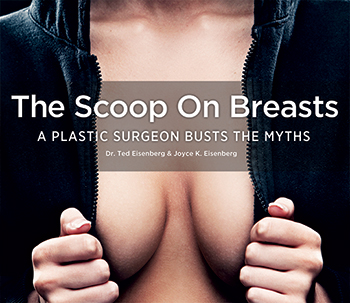Saline vs. Silicone Breast Implants: Busting the Myths
Drawing on his experience with more than 7,000 breast augmentation surgeries and the latest scientific research, Philadelphia Plastic Surgeon Dr. Ted Eisenberg will discuss your breast implant options at your free consultation. You’ll see more than a dozen before & after photos of actual patients who are just like you in height, weight and body frame size, along with post-op pictures showing how women look in their bras, shirts and tank tops. Dr. Eisenberg, an expert in cosmetic breast surgery, will help guide you in choosing the size that’s right for you.
Breast Implant Choices
You can choose saline implants or silicone implants for your breast augmentation surgery. Both have an outer shell made of silicone. Saline implants are filled with sterile saline (salt water); silicone implants are filled with silicone gel. Both types of implants come in different sizes and profiles – low (moderate), medium (moderate plus), and high profile. This refers to the implant’s width and forward projection.
A breast implant shell can be smooth or textured. Dr. Ted Eisenberg has performed all of his breast augmentation surgeries with smooth saline implants or smooth silicone implants. He has never used textured breast implants.
Breast Implant Look and Feel
When women come in for a breast augmentation consultation, they often say they heard that silicone implants look and feel more natural than saline because there is less rippling.
The latest scientific research busts this myth. Using ultrasound scans and patient outcome surveys, Dr. Eric Swanson compared saline and silicone gel implants placed behind the pectoral (chest) muscle and discovered that the rippling seen in both implants is similar. He also reported that there was no statistically significant difference for each group of women in feeling the rippling. His findings are published in Plastic and Reconstructive Surgery (June 4, 2020).
Dr. Eisenberg places breast implants behind the pectoral muscle, not in front of it, because they look more natural in this position.
Breast Implant Deflation Rates
When it comes to deflation rates, saline breast implants have a clear advantage. Earlier in his career, Dr. Eisenberg would have told you that there’s about a 4% chance of your saline implants deflating. Now, the chance of saline breast implant deflation for his patients is 1.8%.
What’s changed? Since 2011, he has been overfilling saline implants 10-13% beyond the manufacturer’s recommended fill volume. This cuts down on folds in the implant shell, which is the most common cause of deflation. By comparison, Mentor Corporation’s 9/2020 brochure reported a 10-year silicone gel implant rupture rate of 24.2%, of which 75% were silent. Allergan and Sientra reported a 10-year rupture rate of ≈10%
Dr. Eisenberg’s latest scientific article, Does Overfilling Smooth Inflatable Saline-filled Breast Implants Decrease the Deflation Rate? Experience with 4761 Augmentation Mammaplasty Patients, was published in Aesthetic Plastic Surgery, an international journal, in March 2021. Click here to read the article.
Post-op management is easier for saline breast implants: When a saline implant deflates, the body safely absorbs the salt water, it’s urinated out and the breast returns to its original size. When a silicone gel implant ruptures, the cohesive gel inside sticks together. You might not notice a change in breast size. To check silicone gel implants for rupture, the FDA and implant manufacturers recommend that you get an MRI three years after surgery and every two years thereafter. This might not be covered by health insurance.
Breast Implant Longevity
Breast implants do not have to be replaced after 10 years. They don’t have an expiration date. They only need to be replaced if they deflate (saline) or rupture (silicone), and they’re not that fragile. In the past year, Dr. Eisenberg took care of three patients with saline implants who wanted to go bigger after 23 years because they had lost weight and/or had children. When he removed the implants, they looked brand new – like the day he put them in.
What Else You Need to Know
Availability: Silicone gel implants are FDA approved for women 22 and older. Saline implants are available to women ages 18 and up.
Incision sizes: A saline implant, which comes empty, can be folded and placed through a smaller incision. It’s filled after placement. A silicone gel implant comes pre-filled and therefore requires a larger incision.
Implant size: There is a limit to how large an implant can fit behind the chest muscle, and it’s partly dependent on the width of each breast. A saline implant acts like a tissue expander, which means a woman can sometimes get a slightly larger size than she could with a silicone gel implant.
Correcting breast asymmetry: It’s not uncommon for your breasts to be different in size. When we talk about breast asymmetry, we are talking about a woman whose breasts differ in size by a half-cup or more. Breasts can be made closer in size by enlarging them with breast implants of different sizes, augmenting the smaller breast, or reducing the bigger breast. Dr. Eisenberg has operated on women whose breasts varied by as much as two cup sizes and was able to make a significant improvement. When your breasts are slightly different sizes, small volume adjustments can be made more easily with saline implants.
Correcting Tuberous Breast Deformity: Many women who come in for breast implants have a concern about this congenital condition in which the breast might have a combination of a tubular appearance, a lack of skin under the nipple, and/or an inframammary crease that’s higher than usual. While plastic surgery websites and Internet forums describe a complicated approach to correcting tuberous breasts using silicone implants, Dr. Eisenberg has achieved an equally aesthetic result by using saline breast implants in a simpler, safer, one-stage procedure. You can read more about this in the article Dr. Eisenberg wrote for the American Journal of Cosmetic Surgery.
Cost: Dr. Eisenberg’s price is all-inclusive. It includes his surgical fee, hospital and anesthesia costs, smooth breast implants, laboratory tests, and all postoperative visits – usually at 1 week, 3 weeks and 3 months. Silicone gel implants cost $1000 more than saline breast implants; that’s because they are more expensive for the manufacturers to produce. When you call our office, we’ll discuss pricing and financing options with you; we work with three reputable companies that are very accommodating to our patients with favorable approvals, quick processing, and minimal red tape.




 CLICK HERE TO BUY
CLICK HERE TO BUY








